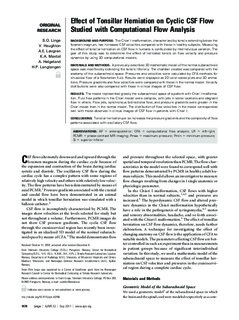| dc.contributor.author | Linge, Svein | |
| dc.contributor.author | Haughton, Victor | |
| dc.contributor.author | Løvgren, Alf Emil | |
| dc.contributor.author | Mardal, Kent-Andre | |
| dc.contributor.author | Helgeland, Anders | |
| dc.contributor.author | Langtangen, Hans Petter | |
| dc.date.accessioned | 2018-02-13T11:36:47Z | |
| dc.date.available | 2018-02-13T11:36:47Z | |
| dc.date.created | 2011-12-01T14:34:07Z | |
| dc.date.issued | 2011 | |
| dc.identifier.citation | American Journal of Neuroradiology. 2011, 32 1474-1481. | nb_NO |
| dc.identifier.issn | 0195-6108 | |
| dc.identifier.uri | http://hdl.handle.net/11250/2484346 | |
| dc.description.abstract | BACKGROUND AND PURPOSE: The Chiari I malformation, characterized by tonsils extending below the foramen magnum, has increased CSF velocities compared with those in healthy subjects. Measuring the effect of tonsillar herniation on CSF flow in humans is confounded by interindividual variation. The goal of this study was to determine the effect of herniated tonsils on flow velocity and pressure dynamics by using 3D computational models.
MATERIALS AND METHODS: A previously described 3D mathematic model of the normal subarachnoid space was modified by extending the tonsils inferiorly. The chamber created was compared with the anatomy of the subarachnoid space. Pressures and velocities were calculated by CFA methods for sinusoidal flow of a Newtonian fluid. Results were displayed as 2D color-coded plots and 3D animations. Pressure gradients and flow velocities were compared with those in the normal model. Velocity distributions were also compared with those in clinical images of CSF flow.
RESULTS: The model represented grossly the subarachnoid space of a patient with Chiari I malformation. Fluid flow patterns in the Chiari model were complex, with jets in some locations and stagnant flow in others. Flow jets, synchronous bidirectional flow, and pressure gradients were greater in the Chiari model than in the normal model. The distribution of flow velocities in the model corresponded well with those observed in clinical images of CSF flow in patients with Chiari I.
CONCLUSIONS: Tonsillar herniation per se increases the pressure gradients and the complexity of flow patterns associated with oscillatory CSF flow. | nb_NO |
| dc.language.iso | eng | nb_NO |
| dc.title | Effect of Tonsillar Herniation on Cyclic CSF Flow Studied with Computational Flow Analysis | nb_NO |
| dc.type | Journal article | nb_NO |
| dc.type | Peer reviewed | nb_NO |
| dc.description.version | publishedVersion | nb_NO |
| dc.rights.holder | 2011 by American Journal of Neuroradiology | nb_NO |
| dc.source.pagenumber | 1474-1481 | nb_NO |
| dc.source.volume | 32 | nb_NO |
| dc.source.journal | American Journal of Neuroradiology | nb_NO |
| dc.identifier.doi | 10.3174/ajnr.A2496 | |
| dc.identifier.cristin | 863400 | |
| cristin.unitcode | 222,58,3,0 | |
| cristin.unitname | Institutt for prosess-, energi- og miljøteknologi | |
| cristin.ispublished | true | |
| cristin.fulltext | original | |
| cristin.qualitycode | 1 | |
